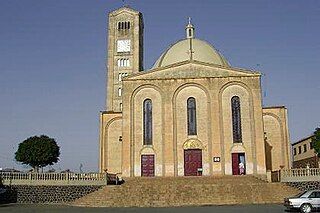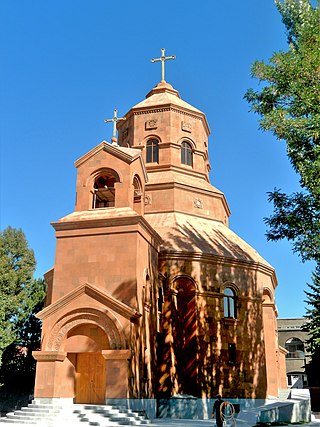
The Eastern Catholic Churches or Oriental Catholic Churches, also called the Eastern-Rite Catholic Churches, Eastern Rite Catholicism, or simply the Eastern Churches, are 23 Eastern Christian autonomous particular churches of the Catholic Church, in full communion with the Pope in Rome. Although they are distinct theologically, liturgically, and historically from the Latin Church, they are all in full communion with it and with each other. Eastern Catholics are a distinct minority within the Catholic Church; of the 1.3 billion Catholics in communion with the Pope, approximately 18 million are members of the eastern churches.

The Armenian Catholic Church is an Eastern Catholic particular churches sui iuris of the Catholic Church. It accepts the leadership of the bishop of Rome, and is therefore in full communion with the universal Catholic Church, including the Latin Church and the 22 other Eastern Catholic Churches. The Armenian Catholic Church is regulated by Eastern canon law, summed up in the Code of Canons of the Eastern Churches.
An apostolic administration in the Catholic Church is administrated by a prelate appointed by the pope to serve as the ordinary for a specific area. Either the area is not yet a diocese, or is a diocese, eparchy or similar permanent ordinariate that either has no bishop or, in very rare cases, has an incapacitated bishop.

The Catholic Church in Georgia, since the 11th-century East–West Schism, has been composed mainly of Latin Church Catholics; a very large community of the Armenian Catholic Church has existed in Georgia since the 18th century.

The Eritrean Catholic Church or Eritrean Eastern Catholic Church is a sui iuris (autonomous) Eastern Catholic church based in Eritrea. As a particular church of the Catholic Church, it is in full communion with the Holy See. It was established in 2015 when its territory was separated from the Ethiopian Catholic Church. The church is organized under a metropolitan bishop who exercises oversight of a number suffragan dioceses. In its liturgical services, it uses the Alexandrian Rite in the Ge'ez language.
As of 2011, most Armenians in Armenia are Christians (97%) and are members of the Armenian Apostolic Church, which is one of the oldest Christian churches. It was founded in the 1st century AD, and in 301 AD became the first branch of Christianity to become a state religion.

Romanian Catholics, like Catholics elsewhere, are members of the Catholic Church under the spiritual leadership of the Pope and Curia in Rome. The administration for the local Latin Church is centered in Bucharest, and comprises two archdioceses and four other dioceses. It is the second largest Romanian denomination after the Romanian Orthodox Church, and one of the 18 state-recognized religions. As of 2021, 5.2% of Romanians identified as Catholic. The 2012 census indicated that there were 741,276 Romanian citizens adhering to the Latin Church. Of these, the largest groups were Hungarians, Romanians, Germans and Slovaks.
The Ordinariate for Armenian Catholics of Romania, based in Gherla, is an ordinariate for Eastern Catholic faithful that is part of the Armenian Catholic Church, itself under the authority of the Pope. It serves Catholic members of Romania's Armenian community living in Transylvania.
A personal ordinariate for former Anglicans, shortened as personal ordinariate or Anglican ordinariate, is an ordinariate, a canonical structure within the Catholic Church established in order to enable "groups of Anglicans" and Methodists to join the Catholic Church while preserving elements of their liturgical and spiritual patrimony.
A particular church is an ecclesiastical community of faithful headed by a bishop, as defined by Catholic canon law and ecclesiology. A liturgical rite, a collection of liturgies descending from shared historic or regional context, depends on the particular church the bishop belongs to. Thus "particular church" refers to an institution, and "liturgical rite" to its ritual practices.
An ordinariate for the faithful of Eastern rite is a geographical ecclesiastical structure for Eastern Catholic communities in areas where no eparchy of their own particular Church has been established. This structure was introduced by the apostolic letter Officium supremi Apostolatus of 15 July 1912.
The Apostolic Administration of the Caucasus is an apostolic administration of the Latin Church in the Catholic Church, established in 1993, with headquarters in Tbilisi, capital of Georgia.
The Ordinariate for Catholics of Armenian Rite in Greece or Armenian Catholic Ordinariate of Greece is an Armenian Catholic Church ecclesiastical territory or ordinariate for the faithful of eastern rite of the Catholic Church for its faithful in Greece.

The Armenian Catholic Ordinariate of Eastern Europe is an Ordinariate (quasi-diocese) of the Armenian Catholic Church for its faithful in certain Eastern European ex-Soviet countries without proper Ordinary for their particular church sui iuris.

The Ordinariate for Eastern (Rite) Catholics in France is a Catholic Ordinariate for Eastern Catholic faithful, jointly for Eastern Catholics in various rites and languages of particular churches sui iuris without proper jurisdiction there.

The Ordinariate for Eastern Catholics in Poland is the Ordinariate for Eastern Catholic faithful for the members of Eastern Catholic particular churches sui iuris in Poland, excepting Ukrainian Greek Catholic Church, which has its own local ordinaries.










